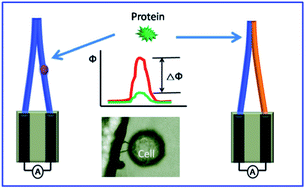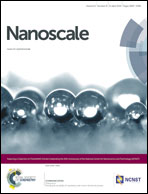Introducing heterojunction barriers into single kinked nanowires for the probe-free detection of proteins and intracellular recording†
Abstract
A nanoprobe based on a single nanowire (NW) possesses substantial potential for biological and in vivo determination. With regard to intracellular detection, minimal invasion and an adjustable detection depth have become crucial challenges. Nanoprobes with small, sharp tips, and long arms are thus desired. Here, we demonstrate a general strategy to prepare a single kinked NW heterojunction with a continuously adjustable angle, length and sharp line-type tip. It is found that heterojunction barriers introduced into kinked NWs can be used as a functional factor to interact with biomolecules and cells. The prepared kinked NW nanosensor is successfully used for the highly-sensitive probe-free detection of hemoglobin and real-time intracellular recording with minimal invasion. The sensing performance is dependent on the amount of heterojunction barriers. Integrated nanoprobes with multi-shaped structures are further designed for multi-functional applications. Introducing heterojunction barriers to kinked NWs provides a substantial opportunity for fabricating functional and integrated nanoprobes for applications in the life sciences.


 Please wait while we load your content...
Please wait while we load your content...